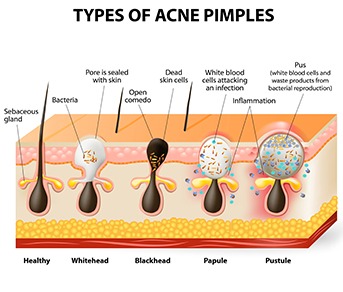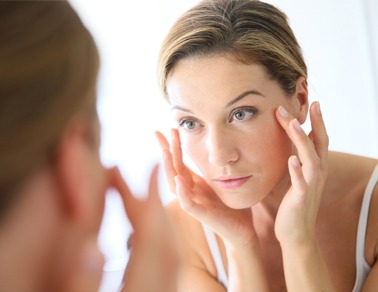Acne & Blemishes
Acne is a very common skin condition characterised by spot breakouts. It usually begins in puberty and varies in severity. Mild acne, for example, is generally not sore and can often be treated with over-the-counter medication. More severe acne types, however, can be painful and in some cases can cause acne scars. In more series cases, prescription medication and support from a dermatologist will likely be required.
Most commonly, acne develops on the:
- Face – affects almost all people with acne
- Back – affects more than 50% of people with acne
- Chest – affects approximately 15% of people with acne
NHS Choices
While acne is a treatable condition, not all acne treatment approaches are successful and more serious cases can go beyond surface level leading to embarrassment and a lack of self-esteem.
What Causes Acne?

What Causes Acne?
Acne is a complicated cycle which occurs within skin pores, often starting weeks before a spot surfaces and developing in the following four stages:
1: Clogged pores
Acne begins with a blocked pore. As skin cells constantly renew themselves, most dead cells will shed every 30-days, revealing fresh skin underneath. If you’re acne prone, however, these dead cells mix with oil and become sticky and instead of shedding, clog pores and trap oil and bacteria inside.
2: Oil secretion
At times of emotional stress or throughout puberty, androgen production increases leading to the over production of oil, or sebum, which further clogs pores. As oil continues to be produced it collects and becomes trapped behind the plug, building up pressure inside the pore.
3: Bacterial growth
The excess production of sebum increases the growth of bacteria known as P.acnes , which grow deep inside the pores. In a plugged follicle, the low oxygen and continually building level of sebum create the perfect environment for the growth and spread of P.acne bacteria.
4: Inflammation
As bacteria ingests the oil, they release inflammatory by-products that leak from the follicle. The body recognises these by-products as foreign objects and kick-starts an immune reaction. Red and white blood cells flock to the infection – resulting in swelling, redness and inflammation, forming what you will recognise as a spot.
Spot Types
Spots caused by acne can be spilt into the following six categories:
Blackheads – Tiny bumps usually black or yellow in colour that develop on the skin. A blackhead is essentially an open clogged hair follicle. The black colour is caused by oxidisation of the debris inside.
Whiteheads – Small white blemishes with white heads. This type of spot is caused by sebum/oil blockages and dead skin cells plugging the follicles.
Papules - Small to medium red bumps that feel tender or sore. This happens when the presence of bacteria under the skin has caused inflammation.
Pustules – Similar to papules but with a build-up of pus inside. Pustules often look like large whiteheads and can be painful to touch. Squeezing them can lead to the development of acne scars so it is advisable to wait until the whitehead is visible.
Nodules – Large inflamed bumps that are firm to the touch. They develop deep within the skin and often cause pain. Nodules should be treated by a dermatologist as over the counter medication may not be strong enough to clear them up.
Cysts – A cyst is the most severe type of spot caused by acne. They are large lumps full of pus that look similar in appearance to boils. Cysts carry the greatest risk of acne scars.
Acne Types
There are a number of different acne types, with each characterised by a different set of symptoms and recommended acne treatment differing for each variety:
Mild Acne - Acne is generally considered to be ‘mild’ when there are a limited number of whiteheads, blackheads, inflamed bumps and lesions visible. This type of acne can often be treated effectively with over-the-counter medication.
Moderate Acne – A higher volume of whiteheads, blackheads, inflamed bumps and lesions are visible and prescription medication is generally advised.
Cystic Acne– Cystic acne, also known as Nodulocystic Acne is when multiple inflamed cysts and nodules are present. Acne may be deep purple and often leaves scars. Treatment by a dermatologist could minimise scarring and in many cases, corticosteroids injections administered by a doctor may be advised to minimise painful inflammation.
Acne Conglobata – One of the most severe acne types, involving inflamed nodules that are connected under the skin to other nodules. Acne Conglobata can affect the neck, chest, arms and buttocks and often leaves scars. It is more typically seen in men and is often caused by taking steroids or testosterone.
Acne Mechanica – This kind of acne is caused by heat, friction and pressure against the skin. Often referred to as sports-induced acne, as wearing sporting gear such as a helmet can often be a catalyst for acne development. Simple measures such as wearing absorbent material underneath sports gear can help.
Acne Treatment

Acne Treatment
Acne treatment depends on severity of symptoms and it can take some months before an improvement is seen. The most common treatment types are outlined below:
Benzoyl peroxide - Benzoyl peroxide is a topical treatment that kills bacteria, reduces inflammation and helps to unclog blocked pores. Upon contact with the skin, it breaks into two parts: benzoic acid and oxygen. Oxygen instantly kills bacteria and as an exfoliate, benzoic acid causes the skin to dry out and peel, eliminating the build-up of dead skin and sebum in your pores. The treatment is available over-the-counter and ranges in strength from 2.5% up to 10%.
Topical retinoids - Topical retinoids remove dead skin cells from the surface of the skin which reduces build-up within the hair follicles. Tretinoin and adapalene are both topical retinoids available in a cream or gel form for the treatment of acne.
Antibiotic for acne - Oral antibiotics are generally used in combination with a topical treatment for more severe cases of acne. Tetracyclines are the most common type of antibiotics prescribed and a course generally lasts between four to six months.
Hormonal therapies - Women who experience flare-ups around the time of their period, or those with hormonal conditions such as polycystic ovary syndrome can benefit from hormonal therapy.
Cocyprindiol – This hormonal treatment helps to slow the production of sebum and can be used to treat more severe acne that hasn’t responded to antibiotics.
Isotretinoin – This drug can only be prescribed by a dermatologist or specially trained GP as it can cause a wide range of side effects. It is mostly taken in tablet form and can help to normalise sebum, prevent clogging in follicles, decrease skin bacteria and reduce redness and swelling in and around spots.
How can we help?
Healthxchange is a trusted supplier of pharmacy products to healthcare professionals and offer a range of treatments which can be used in the treatment of acne to achieve a clearer and healthier looking complexion.
Obagi CLENZIderm M.D System is a prescription strength acne treatment that is available from trained medical professionals following a face-2-face consultation.
Obagi CLENZIderm M.D Systems contain a patented, soluble form of 5% benzoyl peroxide (BPO) which being more easily absorbed by the skin, have been clinically proven to penetrate the follicles for effective reduction of acne.
To find your nearest Obagi Medical stockist, use our clinic finder.